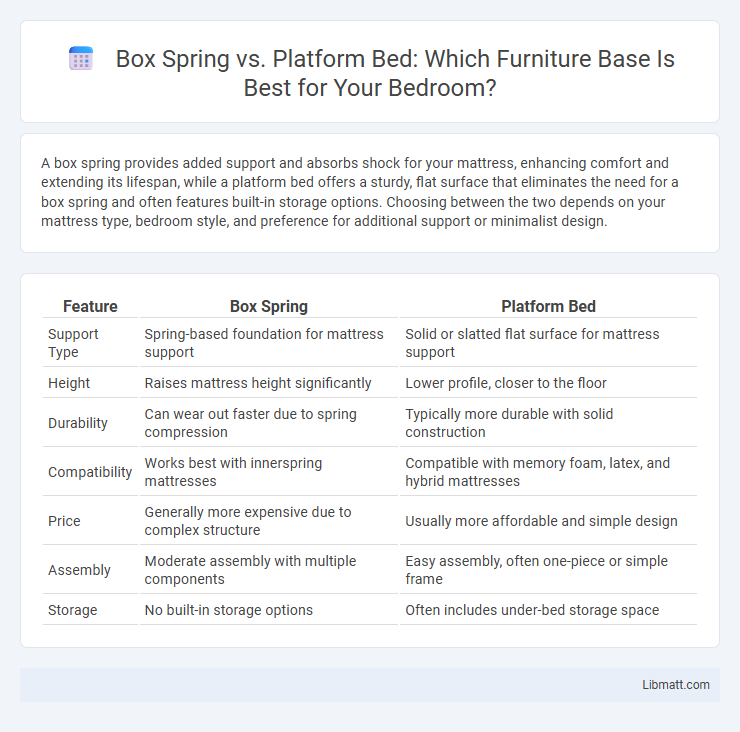A box spring provides added support and absorbs shock for your mattress, enhancing comfort and extending its lifespan, while a platform bed offers a sturdy, flat surface that eliminates the need for a box spring and often features built-in storage options. Choosing between the two depends on your mattress type, bedroom style, and preference for additional support or minimalist design.
Table of Comparison
| Feature | Box Spring | Platform Bed |
|---|---|---|
| Support Type | Spring-based foundation for mattress support | Solid or slatted flat surface for mattress support |
| Height | Raises mattress height significantly | Lower profile, closer to the floor |
| Durability | Can wear out faster due to spring compression | Typically more durable with solid construction |
| Compatibility | Works best with innerspring mattresses | Compatible with memory foam, latex, and hybrid mattresses |
| Price | Generally more expensive due to complex structure | Usually more affordable and simple design |
| Assembly | Moderate assembly with multiple components | Easy assembly, often one-piece or simple frame |
| Storage | No built-in storage options | Often includes under-bed storage space |
Understanding Box Springs: Definition and Purpose
A box spring is a sturdy foundation typically consisting of a wooden frame filled with springs or metal rods, designed to support your mattress and absorb shock, thereby extending mattress life. It provides essential elevation and improves airflow beneath the mattress, contributing to better hygiene and comfort. Understanding the function of a box spring helps you make an informed choice between it and a platform bed, which offers a solid or slatted surface without springs.
What Is a Platform Bed? Key Features Explained
A platform bed is a bed frame designed with a solid or slatted base to support your mattress without the need for a box spring, providing a minimalist and modern aesthetic. Key features include a low-profile frame, durable materials like wood or metal, and often built-in storage options beneath the mattress for space efficiency. This design promotes better mattress ventilation and can enhance the lifespan of your mattress by offering consistent support.
Box Spring vs Platform Bed: Major Differences
Box springs provide height and shock absorption with a wooden frame and springs, supporting a mattress without a solid surface underneath, whereas platform beds feature a solid or slatted surface for mattress support without the need for a box spring. Platform beds typically offer a modern aesthetic with built-in storage options, while box springs are traditional and require a separate bed frame, impacting overall bed height and stability. The choice between a box spring and platform bed affects mattress type compatibility, maintenance, and bedroom design.
Pros and Cons of Using a Box Spring
Box springs provide excellent shock absorption and support, extending mattress lifespan and enhancing comfort by evenly distributing weight. However, they tend to add significant height to your bed, potentially making it harder to get in and out of, and often require specific frame sizes, limiting design flexibility. Your choice between a box spring and platform bed hinges on preference for mattress support, aesthetic appeal, and ease of setup.
Platform Bed Advantages and Drawbacks
Platform beds offer a sleek, modern design with a sturdy, flat surface that eliminates the need for a box spring, reducing overall mattress costs and increasing stability. They provide excellent support and ventilation for memory foam and latex mattresses, enhancing durability and comfort. However, platform beds can be heavier and more challenging to move, and some models may lack under-bed storage options compared to box spring frames.
Mattress Compatibility: Box Spring vs Platform Bed
Box springs are designed to work with innerspring mattresses, providing a sturdy base and shock absorption to extend mattress life, while platform beds offer a solid, flat surface compatible with memory foam, latex, hybrid, and innerspring mattresses. Your mattress choice should align with the bed base; memory foam and latex mattresses perform best on platform beds without the need for a box spring. Box springs add height and support for traditional mattresses, but platform beds ensure better airflow and a modern aesthetic, benefiting mattress durability and comfort.
Durability and Longevity Compared
Platform beds typically offer superior durability and longevity due to their solid wood or metal slats, which provide consistent support without the need for additional components. Box springs, while traditional, can wear out faster because their internal springs and fabric may degrade over time, reducing overall stability. Choosing a platform bed can enhance your sleep investment by ensuring long-lasting support and minimal maintenance.
Assembly and Maintenance Differences
Platform beds typically require minimal assembly, often involving just attaching the legs or a few components, making setup straightforward and quick. Box springs demand more effort in assembly since they must be paired with a compatible bed frame and mattress, occasionally needing additional tools or hardware for stability. Maintenance for platform beds involves simple cleaning and occasional checks for loose screws, whereas box springs require regular inspection for sagging or damage to the springs to ensure long-term support.
Cost Considerations: Which Is More Budget-Friendly?
Platform beds generally prove more budget-friendly than box springs due to their all-in-one design that eliminates the need for a separate foundation. Box springs often require purchasing both the frame and the spring set, increasing overall cost and sometimes necessitating additional accessories. Your choice will depend on evaluating initial expenses alongside long-term durability and mattress support needs.
Box Spring or Platform Bed: Which One Is Right for You?
Choosing between a box spring and a platform bed depends on mattress type, support preference, and aesthetic style. Box springs provide a traditional foundation, enhancing mattress lifespan and shock absorption, ideal for innerspring mattresses. Platform beds offer solid, flat support suited for memory foam or hybrid mattresses, with a modern look and often built-in storage options.
Box Spring vs Platform Bed Infographic

 libmatt.com
libmatt.com